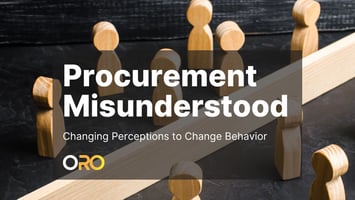From chaos to clarity: Tackling the challenge of data silos in procurement

Procurement has come a long way from the days of filing cabinets and fax machines. Yet for all our progress in digitization, one stubborn problem remains: data silos. Supplier information is scattered across ERP systems, contract lifecycle management tools, e-sourcing platforms, and even personal spreadsheets. The result? Decision-makers spend more time hunting for the right data than acting on it.
In a world where speed, accuracy, and compliance are critical, data silos are more than an inconvenience—they’re a barrier to value creation. To move from chaos to clarity, procurement leaders need to rethink how data is captured, connected, and shared.
The hidden costs of disconnected data
When supplier, contract, and sourcing data live in separate systems, challenges compound quickly. Inconsistent information becomes inevitable—supplier names, tax IDs, and ESG credentials may appear differently across platforms, making it difficult to trust the data. Slow decision-making follows, as teams struggle to locate and reconcile scattered information before acting.
Risk exposure also increases when data is siloed. Without a consolidated view, early warning signs—like financial instability, geopolitical disruption, or ESG non-compliance—can slip through the cracks. Perhaps most frustratingly, silos lead to missed opportunities. Without unified spend and performance data, procurement may fail to identify consolidation opportunities, leverage better pricing, or pursue innovation partnerships.
These costs have strategic consequences. Delayed sourcing decisions can lead to missed market opportunities, and incomplete supplier vetting can result in reputational damage.
Why procurement silos persist
Silos often emerge not from neglect, but from complexity. Many organizations still rely on legacy systems that resist integration, and mergers or acquisitions often bring together disparate processes and technologies. Specialized point solutions—while excellent at specific tasks like contract authoring or supplier diversity tracking—frequently fail to communicate with each other.
Organizational boundaries compound the problem. Procurement data may be owned by different teams—legal, finance, operations—each with its own priorities, definitions, and tech stack. This fragmentation often forces teams into manual workarounds like spreadsheets and email, which are not only inefficient but also create security and version control risks.
Moving toward a single source of truth
The first step to breaking down silos is treating procurement data as a strategic asset rather than a byproduct of transactions. This mindset shift paves the way for intentional investment in connectivity and governance.
Key approaches include:
-
Adopt an orchestration layer: Connect existing systems and workflows rather than replacing them, allowing data to flow seamlessly between tools.
-
Establish data governance: Define clear ownership, entry standards, and validation processes to maintain accuracy.
-
Standardize data formats: Align naming conventions, taxonomy, and metadata to ensure compatibility across platforms.
-
Integrate ESG and risk data: Embed external intelligence—such as credit ratings, sanctions lists, and sustainability certifications—into decision-making.
-
Leverage analytics dashboards: Use unified dashboards for real-time visibility into spend, performance, and risk indicators.
The ORO approach: Unified procurement intelligence
At ORO Labs, we believe that procurement orchestration is the key to overcoming data silos. Our platform doesn’t require organizations to abandon their current tools. Instead, it connects them through a single, intuitive interface that surfaces the right information at the right time.
Centralized supplier profiles pull data from ERP, CLM, sourcing, and risk systems into a single view. This ensures that everyone—from procurement to legal to finance—is working with the same information. Context-aware workflows bring relevant details, such as performance history or contract terms, directly into sourcing events and approvals, reducing the need for time-consuming manual lookups.
Compliance checks are embedded into the workflow, with risk and ESG data updated automatically so decisions are always based on the latest intelligence. Cross-functional collaboration becomes natural when every stakeholder works from a unified dataset, eliminating the delays and misunderstandings caused by fragmented information.
From reactive to proactive
When procurement data is unified, the role of the procurement team changes fundamentally. Instead of chasing data, teams can focus on high-value activities. They can proactively identify supplier innovations that align with corporate goals, anticipate and mitigate risks before they materialize, and advance sustainability and diversity initiatives with measurable results.
This shift also changes procurement’s relationship with the rest of the business. With real-time, accurate data, procurement becomes a strategic advisor, capable of influencing product development, market entry, and long-term planning.
Data silos have long been a frustrating reality for procurement teams, but they are not inevitable. By adopting an orchestration-driven approach and establishing a single source of truth, organizations can turn scattered information into actionable insight. The payoff is not just greater efficiency—it’s the ability to drive growth, resilience, and innovation in an increasingly complex supply chain landscape.





